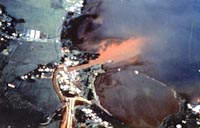Agricultural nonpoint source (NPS) pollution is the leading source of water quality impacts to rivers and lakes. Nitrogen from fertilizers, manure, waste and ammonia turns into nitrite and nitrate.

High levels of these toxins deplete waters of oxygen, killing all of the animals and fish. Nitrates also soak into the ground and end up in drinking water. Health problems can occur as a result of this and they contribute to methemeglopbinemia or blue baby syndrome which causes death in infants. Ammonia, pesticides as well as oil, degreasing agents, metals and other toxins from farm equipment harm and kill aquatic life and animals and cause health problems when they get into drinking water. Bacteria and parasites from animal waste can get into drinking water which can cause illness and death.